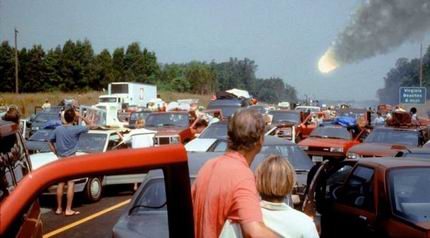
|
|

|
|
| April 26, 2024 |
|
Report: Society is trending toward big collapse 
HOUSTON - Societal collapse, like the kind that took down the Roman Empire, could be just around the corner, according to a report partly funded by NASA's Goddard Space Flight Center.
Prophecies of impending doom go back a long way, but this one has the extra cachet of backing by NASA. The report, posted online in November 2012 by the University of Maryland's Department of Atmospheric and Oceanic Sciences, states that collapsed societies seem to share two features: over-exploitation of natural resources and economic stratification into elites and masses or "commoners." Although the report has been out more than a year, it has drawn attention in recent days from popular media, including The Guardian. The gist of the report is that history is full of stories about the rise and fall of major cultures, so the idea of it happening again shouldn't be written off as kooky. It's based upon a predator-prey model first described in the 1920s by two mathematicians. In this case, the predator is the human population, while nature, or the natural resources of the surrounding environment, is the prey depleted by humans, the authors state. Reasons for societal collapse throughout history are about as varied as weather, including volcanoes, floods, droughts, changes in the course of rivers, foreign invasions, changes in warfare methods and weapons, changes in trade patterns, depletion of mineral resources and civil war, according to the report entitled "A minimal model for human and nature interaction." This report, whose lead author is Safa Motesharrei, a University of Maryland graduate student in mathematics and public policy, takes a more general approach. "We propose a simple model, not intended to describe actual individual cases, but rather to provide a general framework that allows carrying out 'thought experiments' for the phenomenon of collapse and to test changes that would avoid it," the report states. The other two authors are Jorge R. Rivas, University of Minnesota graduate student, and Eugenia Kalnay, professor at University of Maryland's atmospheric and oceanic sciences department. With liberal use of graphs and formulas, the authors posit a model they call "HANDY," for human and nature dynamics. It says that even as technological change can raise the efficiency of resource use, the authors state, it also tends to raise both per capita consumption and the scale of extracting resources. "For example, an increa se in vehicle fuel-efficiency technology tends to enable increased per capita vehicle miles driven, heavier cars, and higher average speeds, which then negate the gains from the increased fuel-efficiency," the report states. In sum, the authors conclude that collapse is "very difficult" to avoid in the face of economic stratification. "However, collapse can be avoided and population can reach equilibrium if the per capita rate of depletion of nature is reduced to a sustainable level, and if resources are distributed in a reasonably equitable fashion," the report states. (Source: Houston Chronicle) Story Date: March 24, 2014
|